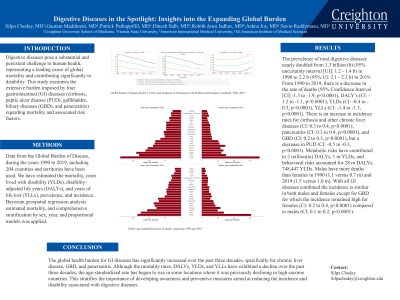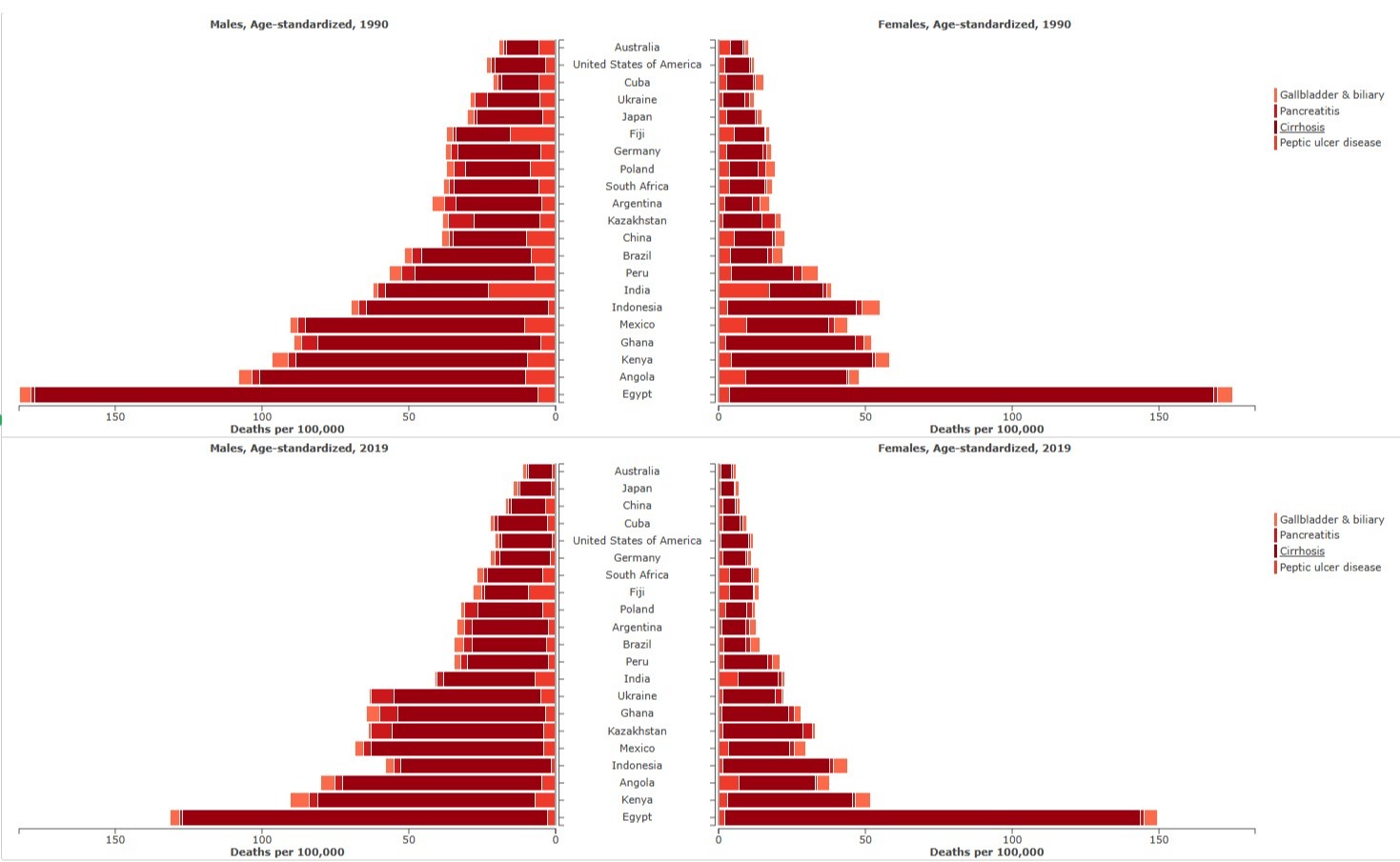Tuesday Poster Session
Category: Practice Management
P4084 - Digestive Diseases in the Spotlight: Insights Into the Expanding Global Burden
Tuesday, October 24, 2023
10:30 AM - 4:00 PM PT
Location: Exhibit Hall

Has Audio

Silpa Choday, MD
Creighton University
Phoenix, Arizona
Presenting Author(s)
Silpa Choday, MD1, Patrick Pathappillil, MD1, Gautam Maddineni, MD2, Dinesh Sidh, MD3, Rohith Arun Jadhav, MD4, Ashna Joy, MD1, Savio Reddymasu, MD1
1Creighton University, Phoenix, AZ; 2Florida State University, Cape Coral, FL; 3American International Medical University, St. Lucia, Gros-Islet, Saint Lucia; 4All American Institute of Medical Science, Black River, Saint Elizabeth, Jamaica
Introduction: Digestive diseases pose a substantial and persistent challenge to human health, representing a leading cause of global mortality and contributing significantly to disability. This study examines the extensive burden imposed by four gastrointestinal (GI) diseases (cirrhosis, peptic ulcer disease (PUD), gallbladder, biliary diseases (GBD), and pancreatitis) in regards to mortality and associated risk factors.
Methods: Data from the Global Burden of Disease, during the years 1990 to 2019, including 204 countries and territories have been used. We have estimated the mortality, years lived with disability (YLDs), disability-adjusted life years (DALYs), and years of life lost (YLLs), prevalence, and incidence. Bayesian geospatial regression analysis estimated mortality, and comprehensive stratification by sex, year, and proportional models was applied.
Results: The prevalence of total digestive diseases nearly doubled from 1.3 billion (b) (95% uncertainty interval [UI]: 1.2 - 1.4 b) in 1990 to 2.2 b (95% UI: 2.1 - 2.3 b) in 2019. From 1990 to 2019, there is a decrease in the rate of deaths (95% Confidence Interval [CI] -1.3 to -1.9, p< 0.0001), DALY’s (CI: -1.2 to -1.1, p< 0.0001), YLDs (CI: -0.4 to -0.3, p< 0.0001), YLLs (CI: -1.4 to -1.3, p< 0.0001). There is an increase in incidence rates for cirrhosis and other chronic liver diseases (CI: 0.3 to 0.4, p< 0.0001), pancreatitis (CI: 0.3 to 0.4, p< 0.0001), and GBD (CI: 0.2 to 0.3, p< 0.0001), but a decrease in PUD (CI: -0.5 to -0.3, p< 0.0001). Metabolic risks have contributed to 2 million(m) DALYs, 1 m YLDs, and behavioral risks accounted for 28 m DALYs, 748,447 YLDs. Males have more deaths than females in 1990 (1.1 versus 0.7 m) and 2019 (1.5 versus 1.0 m). With all GI diseases combined the incidence is similar in both males and females except for GBD for which the incidence remained high for females (CI: 0.2 to 0.4, p< 0.0001) compared to males (CI: 0.1 to 0.2, p< 0.0001).
Discussion: The global health burden for GI diseases has significantly increased over the past three decades, specifically for chronic liver disease, GBD, and pancreatitis. Although the mortality rates, DALYs, YLDs, and YLLs have exhibited a decline over the past three decades, the age-standardized rate has begun to rise in some locations where it was previously declining in high-income countries. This stratifies the importance of developing awareness and preventive measures aimed at reducing the incidence and disability associated with digestive diseases.

Disclosures:
Silpa Choday, MD1, Patrick Pathappillil, MD1, Gautam Maddineni, MD2, Dinesh Sidh, MD3, Rohith Arun Jadhav, MD4, Ashna Joy, MD1, Savio Reddymasu, MD1. P4084 - Digestive Diseases in the Spotlight: Insights Into the Expanding Global Burden, ACG 2023 Annual Scientific Meeting Abstracts. Vancouver, BC, Canada: American College of Gastroenterology.
1Creighton University, Phoenix, AZ; 2Florida State University, Cape Coral, FL; 3American International Medical University, St. Lucia, Gros-Islet, Saint Lucia; 4All American Institute of Medical Science, Black River, Saint Elizabeth, Jamaica
Introduction: Digestive diseases pose a substantial and persistent challenge to human health, representing a leading cause of global mortality and contributing significantly to disability. This study examines the extensive burden imposed by four gastrointestinal (GI) diseases (cirrhosis, peptic ulcer disease (PUD), gallbladder, biliary diseases (GBD), and pancreatitis) in regards to mortality and associated risk factors.
Methods: Data from the Global Burden of Disease, during the years 1990 to 2019, including 204 countries and territories have been used. We have estimated the mortality, years lived with disability (YLDs), disability-adjusted life years (DALYs), and years of life lost (YLLs), prevalence, and incidence. Bayesian geospatial regression analysis estimated mortality, and comprehensive stratification by sex, year, and proportional models was applied.
Results: The prevalence of total digestive diseases nearly doubled from 1.3 billion (b) (95% uncertainty interval [UI]: 1.2 - 1.4 b) in 1990 to 2.2 b (95% UI: 2.1 - 2.3 b) in 2019. From 1990 to 2019, there is a decrease in the rate of deaths (95% Confidence Interval [CI] -1.3 to -1.9, p< 0.0001), DALY’s (CI: -1.2 to -1.1, p< 0.0001), YLDs (CI: -0.4 to -0.3, p< 0.0001), YLLs (CI: -1.4 to -1.3, p< 0.0001). There is an increase in incidence rates for cirrhosis and other chronic liver diseases (CI: 0.3 to 0.4, p< 0.0001), pancreatitis (CI: 0.3 to 0.4, p< 0.0001), and GBD (CI: 0.2 to 0.3, p< 0.0001), but a decrease in PUD (CI: -0.5 to -0.3, p< 0.0001). Metabolic risks have contributed to 2 million(m) DALYs, 1 m YLDs, and behavioral risks accounted for 28 m DALYs, 748,447 YLDs. Males have more deaths than females in 1990 (1.1 versus 0.7 m) and 2019 (1.5 versus 1.0 m). With all GI diseases combined the incidence is similar in both males and females except for GBD for which the incidence remained high for females (CI: 0.2 to 0.4, p< 0.0001) compared to males (CI: 0.1 to 0.2, p< 0.0001).
Discussion: The global health burden for GI diseases has significantly increased over the past three decades, specifically for chronic liver disease, GBD, and pancreatitis. Although the mortality rates, DALYs, YLDs, and YLLs have exhibited a decline over the past three decades, the age-standardized rate has begun to rise in some locations where it was previously declining in high-income countries. This stratifies the importance of developing awareness and preventive measures aimed at reducing the incidence and disability associated with digestive diseases.

Figure: Global Age-standardized ratio of the four digestive diseases mortality comparing 1990 and 2019
Disclosures:
Silpa Choday indicated no relevant financial relationships.
Patrick Pathappillil indicated no relevant financial relationships.
Gautam Maddineni indicated no relevant financial relationships.
Dinesh Sidh indicated no relevant financial relationships.
Rohith Arun Jadhav indicated no relevant financial relationships.
Ashna Joy indicated no relevant financial relationships.
Savio Reddymasu indicated no relevant financial relationships.
Silpa Choday, MD1, Patrick Pathappillil, MD1, Gautam Maddineni, MD2, Dinesh Sidh, MD3, Rohith Arun Jadhav, MD4, Ashna Joy, MD1, Savio Reddymasu, MD1. P4084 - Digestive Diseases in the Spotlight: Insights Into the Expanding Global Burden, ACG 2023 Annual Scientific Meeting Abstracts. Vancouver, BC, Canada: American College of Gastroenterology.
